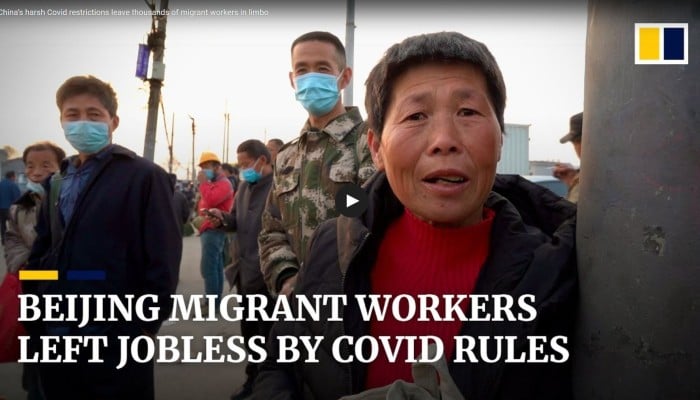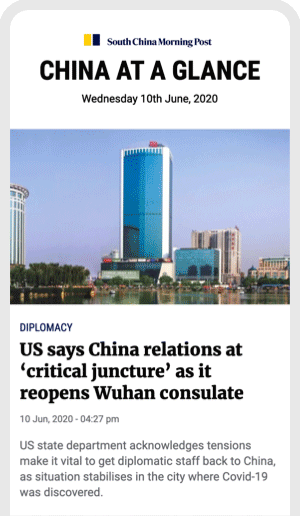Dear Global Impact Readers,
China had seemingly set itself out as an example of how to deal with the coronavirus, with its economy picking up after having been floored at the start of 2020.
But the latest wave of cases, mainly in Shanghai, has delivered another blow and raised questions over the outlook for the world’s second largest economy, despite first quarter growth hitting 4.8 per cent.
In this issue, Wendy Wu, the economy desk editor at the SCMP, looks back at the start of the year and ahead to what is to come for China’s economy for the remainder of 2022.
Andrew Mullen
Production Editor, EconomyWhat does Beijing have left in its locker as China’s economy walks the tightrope?
A call for a contingency plan?
China’s growth over the past decades was once the envy of the world, but now questions are being raised about how long it will take to reverse the current downturn and contain any long-term consequences.
Growth of 4.8 per cent in the first quarter surprised the market at the start of this week, but any optimism from the rosy start to the year is set to be short lived as the worst coronavirus outbreak in two years has dashed hopes of solid expansion and challenged Beijing’s ambitious target for gross domestic product growth of “around 5.5 per cent” this year.
Lockdowns have started to take a bite out of China’s economy, with retail sales dropping by 3.5 per cent in March, falling for the first time since August 2020. Investment and industrial output has also weakened, while more urgently, jobless rates in big cities have risen to a record high.
Many have warned that the worst is yet to come as the impact of lockdowns in Shanghai has not yet been fully reflected in first quarter indicators, and will only take a toll from April.
Beijing is facing difficulties unseen in recent years: increasing decoupling risks from the United States and its Western allies, the unresolved fate of Chinese companies listed in the US market, global price turbulence for commodities it relies on to fuel growth, while every move with Russia has been put under the microscope amid a protracted war in Ukraine and sanctions against Moscow.
At home, it has to control the highly transmissible Omicron variant that has spread across the country and contain the corresponding economic downturn before the crucial 20th party congress in the autumn.
It is also carefully guarding against capital outflows ahead of a much-expected interest rate increase by the US Federal Reserve next month and a possible hike by the European Central Bank in July.
Logistics restrictions have impeded not only exports, but also made it hard for manufacturers to get their hands on imported materials, which may further hit shipments.
The State Council has issued directions to ensure logistics flows, which were quickly followed up by detailed measures from road, rail and aviation regulators.
Shanghai and Changchun have gradually restored production of key industries and big companies, but insiders have warned the full recovery may take months.
China’s central bank has refrained from large-scale easing. The much-anticipated reserve requirement ratio cut was half of what the market expected as the central bank insisted that liquidity is sufficient.
Instead of lowering the guidance rates for banks’ lending and mortgage rates, financial regulators have taken moderate steps to offer funding, including a rollover of the relending quota, a push for commercial banks to increase funding for local government infrastructure projects and the extension of the overdue loans to pandemic-hit borrowers.
Regulators are also warning of financing risks from lending to the real estate sector and local governments.
As the room for interest rate cuts is limited, calls have mounted for more forceful fiscal policy to support the ailing economy, especially to small and medium-sized businesses.
Central bank governor Yi Gang told the Boao Forum for Asia this week that the People’s Bank of China is “ready to support small and medium enterprises with more instruments if needed”.
Supply chain disruption due to the current virus wave might be short term, but foreign business leaders have warned about the ramifications of China’s highly restrictive containment measures in terms of attracting foreign capital and talent.
Many have called for the controls to be adjusted to better cope with the Omicron variant, such as focusing on mass vaccination instead of mass testing, the use of mixed booster shots and more public education on the different variants.
The second quarter will be critical to determine the trajectory of the economy for the whole year, with all eyes on an upcoming Politburo meeting for signs of any contingency plans to facilitate a quick rebound.
- South China Morning Post, SCMP -
Dear Global Impact Readers,
China had seemingly set itself out as an example of how to deal with the coronavirus, with its economy picking up after having been floored at the start of 2020.
But the latest wave of cases, mainly in Shanghai, has delivered another blow and raised questions over the outlook for the world’s second largest economy, despite first quarter growth hitting 4.8 per cent.
In this issue, Wendy Wu, the economy desk editor at the SCMP, looks back at the start of the year and ahead to what is to come for China’s economy for the remainder of 2022.
Andrew Mullen
Production Editor, EconomyWhat does Beijing have left in its locker as China’s economy walks the tightrope?
A call for a contingency plan?
China’s growth over the past decades was once the envy of the world, but now questions are being raised about how long it will take to reverse the current downturn and contain any long-term consequences.
Growth of 4.8 per cent in the first quarter surprised the market at the start of this week, but any optimism from the rosy start to the year is set to be short lived as the worst coronavirus outbreak in two years has dashed hopes of solid expansion and challenged Beijing’s ambitious target for gross domestic product growth of “around 5.5 per cent” this year.
Lockdowns have started to take a bite out of China’s economy, with retail sales dropping by 3.5 per cent in March, falling for the first time since August 2020. Investment and industrial output has also weakened, while more urgently, jobless rates in big cities have risen to a record high.
Many have warned that the worst is yet to come as the impact of lockdowns in Shanghai has not yet been fully reflected in first quarter indicators, and will only take a toll from April.
Beijing is facing difficulties unseen in recent years: increasing decoupling risks from the United States and its Western allies, the unresolved fate of Chinese companies listed in the US market, global price turbulence for commodities it relies on to fuel growth, while every move with Russia has been put under the microscope amid a protracted war in Ukraine and sanctions against Moscow.
At home, it has to control the highly transmissible Omicron variant that has spread across the country and contain the corresponding economic downturn before the crucial 20th party congress in the autumn.
It is also carefully guarding against capital outflows ahead of a much-expected interest rate increase by the US Federal Reserve next month and a possible hike by the European Central Bank in July.
Logistics restrictions have impeded not only exports, but also made it hard for manufacturers to get their hands on imported materials, which may further hit shipments.
The State Council has issued directions to ensure logistics flows, which were quickly followed up by detailed measures from road, rail and aviation regulators.
Shanghai and Changchun have gradually restored production of key industries and big companies, but insiders have warned the full recovery may take months.
China’s central bank has refrained from large-scale easing. The much-anticipated reserve requirement ratio cut was half of what the market expected as the central bank insisted that liquidity is sufficient.
Instead of lowering the guidance rates for banks’ lending and mortgage rates, financial regulators have taken moderate steps to offer funding, including a rollover of the relending quota, a push for commercial banks to increase funding for local government infrastructure projects and the extension of the overdue loans to pandemic-hit borrowers.
Regulators are also warning of financing risks from lending to the real estate sector and local governments.
As the room for interest rate cuts is limited, calls have mounted for more forceful fiscal policy to support the ailing economy, especially to small and medium-sized businesses.
Central bank governor Yi Gang told the Boao Forum for Asia this week that the People’s Bank of China is “ready to support small and medium enterprises with more instruments if needed”.
Supply chain disruption due to the current virus wave might be short term, but foreign business leaders have warned about the ramifications of China’s highly restrictive containment measures in terms of attracting foreign capital and talent.
Many have called for the controls to be adjusted to better cope with the Omicron variant, such as focusing on mass vaccination instead of mass testing, the use of mixed booster shots and more public education on the different variants.
The second quarter will be critical to determine the trajectory of the economy for the whole year, with all eyes on an upcoming Politburo meeting for signs of any contingency plans to facilitate a quick rebound.
|
Was this newsletter forwarded to you? Subscribe here
|

|
|
|
|
|
23 April 2022 |
|
Welcome to our 1,639 newly joined SCMP Global Impact readers who signed up in the past week.
|
|
Dear Global Impact Readers,
China had seemingly set itself out as an example of how to deal with the coronavirus, with its economy picking up after having been floored at the start of 2020.
But the latest wave of cases, mainly in Shanghai, has delivered another blow and raised questions over the outlook for the world’s second largest economy, despite first quarter growth hitting 4.8 per cent.
In this issue, Wendy Wu, the economy desk editor at the SCMP, looks back at the start of the year and ahead to what is to come for China’s economy for the remainder of 2022.
Andrew Mullen
Production Editor, Economy
What does Beijing have left in its locker as China’s economy walks the tightrope?
A call for a contingency plan?
China’s growth over the past decades was once the envy of the world, but now questions are being raised about how long it will take to reverse the current downturn and contain any long-term consequences.
Growth of 4.8 per cent in the first quarter surprised the market at the start of this week, but any optimism from the rosy start to the year is set to be short lived as the worst coronavirus outbreak in two years has dashed hopes of solid expansion and challenged Beijing’s ambitious target for gross domestic product growth of “around 5.5 per cent” this year.
Lockdowns have started to take a bite out of China’s economy, with retail sales dropping by 3.5 per cent in March, falling for the first time since August 2020. Investment and industrial output has also weakened, while more urgently, jobless rates in big cities have risen to a record high.
Many have warned that the worst is yet to come as the impact of lockdowns in Shanghai has not yet been fully reflected in first quarter indicators, and will only take a toll from April.
Beijing is facing difficulties unseen in recent years: increasing decoupling risks from the United States and its Western allies, the unresolved fate of Chinese companies listed in the US market, global price turbulence for commodities it relies on to fuel growth, while every move with Russia has been put under the microscope amid a protracted war in Ukraine and sanctions against Moscow.
At home, it has to control the highly transmissible Omicron variant that has spread across the country and contain the corresponding economic downturn before the crucial 20th party congress in the autumn.
It is also carefully guarding against capital outflows ahead of a much-expected interest rate increase by the US Federal Reserve next month and a possible hike by the European Central Bank in July.
Logistics restrictions have impeded not only exports, but also made it hard for manufacturers to get their hands on imported materials, which may further hit shipments.
The State Council has issued directions to ensure logistics flows, which were quickly followed up by detailed measures from road, rail and aviation regulators.
Shanghai and Changchun have gradually restored production of key industries and big companies, but insiders have warned the full recovery may take months.
China’s central bank has refrained from large-scale easing. The much-anticipated reserve requirement ratio cut was half of what the market expected as the central bank insisted that liquidity is sufficient.
Instead of lowering the guidance rates for banks’ lending and mortgage rates, financial regulators have taken moderate steps to offer funding, including a rollover of the relending quota, a push for commercial banks to increase funding for local government infrastructure projects and the extension of the overdue loans to pandemic-hit borrowers.
Regulators are also warning of financing risks from lending to the real estate sector and local governments.
As the room for interest rate cuts is limited, calls have mounted for more forceful fiscal policy to support the ailing economy, especially to small and medium-sized businesses.
Central bank governor Yi Gang told the Boao Forum for Asia this week that the People’s Bank of China is “ready to support small and medium enterprises with more instruments if needed”.
Supply chain disruption due to the current virus wave might be short term, but foreign business leaders have warned about the ramifications of China’s highly restrictive containment measures in terms of attracting foreign capital and talent.
Many have called for the controls to be adjusted to better cope with the Omicron variant, such as focusing on mass vaccination instead of mass testing, the use of mixed booster shots and more public education on the different variants.
The second quarter will be critical to determine the trajectory of the economy for the whole year, with all eyes on an upcoming Politburo meeting for signs of any contingency plans to facilitate a quick rebound.
|
|
|
|
|
|

|
|
China’s manufacturers fear they ‘can’t survive another round’ of coronavirus outbreaks, lockdowns
|
| • |
Travel restrictions to limit the spread of the coronavirus are causing disruptions to logistics and supply chains, while ports are also experiencing delays | | | • | Imports suffered their first fall in 18 months in March, and there are rising concerns that restrictions will weigh on exports and economic growth
|
|
|
Fabric weaver Tony Xie never expected that moving his products from one side of the road to the other would be mission impossible. Normally, it would be a simple process to transport the white fabrics that his factory produces to the printing-and-dyeing plant across the road, where patterns and colours are added for his overseas customers. Read more
|
|
|
|

|
|
China GDP: economy grew, but ‘more pain will come’ as coronavirus, lockdown pressures weigh on outlook
|
| • |
China’s economy grew by 4.8 per cent in the first quarter of 2022 compared with a year earlier, up from the 4 per cent growth seen in the fourth quarter of last year | | | • | Retail sales fell by 3.5 per cent in March from a year earlier, while industrial production grew by 5 per cent last month and the surveyed jobless rate rose to 5.8 per cent
|
|
|
China’s first quarter growth beat expectations, but weaknesses have been highlighted by the ongoing coronavirus wave hanging over the economy, with questions being asked if Beijing will take further action to guard against multiple headwinds. Gross domestic product (GDP) growth of 4.8 per cent in the first three months of 2022 compared with a year earlier, which was confirmed on Monday, was higher than the 4 per cent expansion registered in the previous quarter and is in stark contrast to the start of 2020, when China’s economy shrank by 6.8 per cent. Read more
|
|

|
|
China’s rising household debt is shattering dreams of financial freedom, and ‘fears are spreading’
|
| • |
Salary reductions, lay-offs, lockdowns and regulatory crackdowns are upending the lives of those who were once the envy of China’s middle class | | | • | If coronavirus-induced lockdowns and restrictions drag out for more than two months, some warn that the impact could be ‘unimaginable’
|
|
|
Across China, people such as Eli Mai, a 40-year-old sales manager at a consulting firm in Guangzhou, were long held up as the envy of the middle class – empowering examples of what could be achieved with a decent job. But that was back when China’s economic growth was the envy of the world. Read more
|
|

|
|
|

|
|
Covid-19 outbreaks dampen China’s infrastructure spending push
|
| • |
China’s hardline zero-Covid policy is putting financial pressure on local governments and ‘limiting’ their ability to spend on infrastructure | | | • | Beijing has set a growth target of ‘around 5.5 per cent’ this year and infrastructure investment is a key driver of the economy
|
|
|
China may have turned to its old playbook of infrastructure spending to drive economic growth, but with many local governments facing financial constraints due to the worst coronavirus outbreak in two years, such expenditure may not be as effective as in the past, analysts said. Beijing’s hardline zero-Covid policy is putting pressure on cash-strapped local authorities, who have responded to Omicron outbreaks with costly lockdowns, travel bans and mass testing. Read more
|
|

|

|
|
Chinese debt sell-off likely to continue as yield advantage over US bonds disappears
|
| • |
The yield on the 10-year Treasury note climbed to 2.78 per cent on Monday, surpassing the 2.75 per cent premium for China’s 10-year government bond | | | • | Analysts warn that ongoing capital outflows coupled with growing depreciation pressure on the yuan may be destabilising for China’s financial markets
|
|
|
Capital outflows from China are expected to continue in coming weeks after an exodus of foreign funds from Chinese sovereign bonds in March, experts said, as the country’s yield advantage over US Treasuries disappeared for the first time since 2010. On Monday, 10-year US yields climbed to 2.78 per cent, supporting the US dollar and surpassing the 2.75 per cent yield for China’s benchmark 10-year government bond. Read more
|
|

|
|
What next for China’s zero-Covid stance as lockdowns spark economic worries?
|
| • |
As many as 73 of China’s top 100 cities are under some form of lockdown as the country battles its worst outbreak of the pandemic | | | • | With jobs and economic data at stake months ahead of a key Communist Party congress, the impact, if any, on the stringent rules remains to be seen
|
|
|
Anxiety was getting the better of Xiao Ke. The trading company owner from Hangzhou was supposed to have delivered a Greece-bound cosmetics shipment to Shanghai earlier this month for customs clearance. But there had been no truck services available for weeks. That is because Shanghai has been under near total lockdown since last month, as authorities stick with a “dynamic zero” Covid-19 strategy to contain the country’s worst wave since the pandemic hit in early 2020, and provinces next to the eastern logistics hub scramble to block transport links to cut off virus transmission chains. Read more
|
|
|
To keep track of the latest global news developments, follow daily coverage on our website or focus on stories about China’s economy here.
In our next issue, our China desk will look back at the crash of China Eastern Airlines flight MU5735 and the fallout a month on from the tragedy that saw 132 passengers and crew lose their lives.
We welcome your feedback. Email me at globalimpact@scmp.com or tweet me at @Wendy_Wu_SCMP. Plus, be sure to check out our economy news feed for the latest news and analysis.
All the best,
Wendy Wu
|

|
|
Wendy Wu
Editor, Political Economy
|
|
|
|
|
|
|
Hello, thank you for reading Global Impact.
Our mission is to lead the global conversation about China and this flagship newsletter is one way our Editorial team contributes toward this goal.
Serving readers and helping them get closer to stories that matter are paramount to us because keeping abreast of today’s news cycle has never been more important.
Understanding China means understanding the world. For more in-depth, expert coverage on how China and Asia impact the world, please consider a digital subscription to SCMP.
|
|
|
|
|
| SCMP NEWSLETTERS THAT MAY INTEREST YOU |

China at a Glance
A wealth of insights giving you the inside story on China every day.
China Economic Update
The latest developments from trade relations to growth rates and other key economic data.
Inside China Tech
Our weekend newsletter covering the biggest stories and updates from the tech centres of China.
VIEW AND SIGN UP
|

|
|

|
|
|
Hong Kong
China
Asia
World
Economy
Business
Tech
Comment
|
|
|
|
This email was sent to [email]
unsubscribe from this list
update subscription preferences
South China Morning Post Publishers Ltd · 19/F Tower 1 · 1 Matheson Street · Hong Kong · Hong Kong
Copyright © 2022 South China Morning Post Publishers Ltd. All rights reserved.
|















